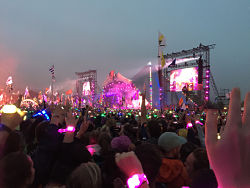A few weeks ago I went to the Glastonbury festival for the first time. It’s the largest ‘greenfield’ music and performing arts festival in the world – you’ll understand why I put greenfield in inverted commas if you’ve seen pictures!
As you may recall from previous blogs, attending Glastonbury was something very much outside my comfort zone and, having committed to going some months ago, I was beginning to have serious misgivings about whether it was ‘for me’.
So, you’re probably wondering what it was like? A few of you have asked – which is why I decided to write this follow up blog.
I don’t think it’d be possible to really convey what Glastonbury is like to someone who’s never been, and I’m sure it’s beyond my literary skills, but I’ll try and give you a flavour.
Imagine a town that springs up overnight during a gold rush. Except that, rather than the few thousands who typically took up residence in such towns, this one is vast, covering 900 acres with a perimeter that is about eight and a half miles long, and accommodating perhaps 175,000 people from all walks of life, who all arrive on the same day. There’s a ‘town centre’ with streets of mud, crammed with people and lined with restaurants, bars and wooden stalls selling all manner of goods, and these streets link huge public areas, with open air auditoriums or vast red and blue striped marquees. Beyond the ‘town centre’, in every direction, are fields full of tents.

Now, teleport into this scene, hundreds of bands and performers, covering every genre and including such famous acts as Adele, Muse, Coldplay, ELO, Madness, Beck, Cyndi Lauper, Chvrches, The Feeling and Will Young, as well as lesser known artists (to me at least) like Laura Mvula, Jake Bugg and Haelos, to name just a few.
And then there’s the mud: The flash floods of the week before, combined with the footfall of so many people meant that all the paths, ‘streets’ and public areas were a sea of mud, though semi-sophisticated walkways meant that there was at least some firm footing below the mud on the major routes. Elsewhere, the mud sucked and grasped at your boots as you tried to navigate your way around, or made the footing treacherously slippery.
It was noisy, exhilarating, boisterous, easy-going, friendly, and physically exhausting. According to my iPhone, we walked more than 10 miles every day. And we spent up to 10 hours standing or walking each day without ever sitting down.
Most of all, it was one of the most amazing experiences of my life so far – and yes, I’ll probably do it again.
And to think, I’d been scared to take the first step that enabled me to have this experience!
I owe it all to my partner, who suggested the idea of going, encouraged me when I had doubts and, whilst acknowledging that yes, the experience would be outside my comfort zone, showed absolute and unwavering faith in my ability to cope with the mud, the toilets, the noise, the crowds and the energy and stamina required. (Only afterwards did he admit surprise at just how well I adapted!)
When you think about it, that role of encouraging people to believe in their abilities, to take a step into the unknown, to do something new, is a key part of being a successful trainer.
It’s also a key part of the approach I’ve always taken to training design. Many of our materials encourage people to take a leap of faith, to trust in an experience, and by doing so, learn in new and unexpected ways. A
murder mystery, for example, might not seem particularly relevant to time management or teamwork - but it is, and it delivers a great learning opportunity.
If you’re not used to using this type of experiential training to deliver outstanding learning, you might, in fact, be surprised what can be achieved if you step outside your own comfort zone, into what I call the learning zone. (I’ll explain more about what I mean by learning zone, next time.)
Trainers’ Library will help you push the boundaries of your training with a huge range of experiential and fun training activities you can run with the confidence that they’ve been tried and tested. What’s more, we’re here to help – there’s even a
new mentoring service for our Full and Pro customers, where we’ll provide hands on support and expertise when you need it.